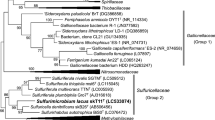Abstract
Two strains of a new purple sulfur bacterium were isolated in pure culture from the littoral sediment of a saline lake (Mahoney Lake, Canada) and a marine microbial mat from the North Sea island of Mellum, respectively. Single cells were vibrioid-to spirilloid-shaped and motile by means of single polar flagella. Intracellular photosynthetic membranes were of the vesicular type. As photosynthetic pigments, bacteriochlorophyll a and the carotenoids lycopene, rhodopin, anhydrorhodovibrin, rhodovibrin and spirilloxanthin were present.
Hydrogen sulfide and elemental sulfur were used under anoxic conditions for phototrophic growth. In addition one strain (06511) used thiosulfate. Carbon dioxide, acetate and pyruvate were utilized by both strains as carbon sources. Depending on the strain propionate, succinate, fumarate, malate, tartrate, malonate, glycerol or peptone may additionally serve as carbon sources in the light. Optimum growth rates were obtained at pH 7.2, 33 °C, 50 μmol m-2 s-1 intensity of daylight fluorescent tubes and a salinity of 2.2–3.2% NaCl. During growth on sulfide, up to ten small sulfur globules were formed inside the cells. The strains grew microaerophilic in the dark and exhibited high specific respiration rates. No vitamins were required for growth. The DNA base composition was 61.0–62.4 mol% G+C.
The newly isolated bacterium belongs to the family chromatiaceae and is described as a member of a new genus and species, Thiorhodovibrio winogradskyi gen. nov. and sp. nov. with the type strain SSP1, DSM No. 6702.
Similar content being viewed by others
References
Bavendamm W (1924) Die farblosen und roten Schwefelbakterien des Süß- und Salzwassers. Kollwitz R (ed): Pflanzenforschung Heft 2. Gustav Fischer, Jena
Cole RM, Popkin TJ (1981) Electron microscopy. In: Gerhardt P, Murray RGE, Costilow RN, Nester EW, Wood WA, Krieg NE, Phillips B (eds) Manual of methods for general bacteriology. American Society for Microbiology, Washington, pp 36–51
DeWit R, Gemerden H va (1987) Chemolithotrophic growth of the purple sulfur bacterium Thiocapsa roseopersicina. FEMS Microbiol Ecol 45: 117–126
deWit R, Gemerden H van (1989) Growth of the photoatotrophic purple sulfur bacterium Thiocapsa roseopersicina under oxic/anoxic regimens in the light. FEMS Microbiol Ecol 73: 69–76
Gemerden H van, Tughan CS, DeWit R, Herbert RA (1989) Laminated microbial ecosystems on sheltered beaches in Scapa Flow, Orkney Islands. FEMS Microbiol Ecol 62: 87–102
Goodwin TW (1980) The biochemistry of the carotenoids, vol 1. Plants, 2nd edn. Chapman and Hall, London New York, p 377
Hartree EF (1972) Determination of protein: a modification of the LOWRY-method that gives a linear photometric response. Anal Biochem 48: 422–427
Horridge GA, Tamm SL (1969) Critical point drying for scanning microscopic study of ciliary motion. Science 163: 817–818
Jørgensen BB, Des Marais DJ (1986) Competition for sulfides among colorless and purple sulfur bacteria in cyanobacterial mats. FEMS Microbiol Ecol 38: 179–186
Jørgensen BB, Bak F (1991) Pathways and sulfate reduction in a marine sediment (Kattegat, Denmark). Appl Environ Microbiol 57: 847–856
Kämpf C, Pfennig N (1980) Capacity of Chromatiaceae for chemotrophic growth. Specific respiration rates of Thiocystis violacea and Chromatium vinosum. Arch Microbiol 127: 125–135
Luther GW, Church TM, Sandlark JR, Cosman M (1986) Inorganic and organic sulfur cycling in salt-marsh pore waters. Science 232: 746–749
Meshbah M, Premachandrou U, Whitman W (1989) Precise measurement of the G+C content of deoxyribonucleic acid by high performance liquid chromatography. Int J Syst Bacteriol 39: 159–167
Nicholson JAM, Stolz JF, Pierson BK (1987) Structure of a microbial mat at Great Sippewisset March, Cape Cod, Massachusetts. FEMS Microbiol Ecol 45: 343–364
Overmann J, Beatty JT, Hall KJ, Pfennig N, Northcote TG (1991) Characterization of a dense, purple sulfur bacterial layer in a meromictic salt lake. Limnol Oceanogr 36: 846–859
Parkin TB, Brock TD (1980) Photosynthetic bacterial production in lakes: The effects of light intensity. Limnol Oceanogr 25: 711–718
Pfennig N (1978) Rhodocyclus purpureus gen. nov. and spec. nov., a ring-shaped, vitamin B12-requiring member of the family Rhodospirillaceae. Int J Syst Bacteriol 28: 283–288
Pfennig N (1989) Ecology of phototrophic purple and green sulfur bacteria. In: Schlegel HG, Bowien B (eds) Autotrophic bacteria. Springer, Berlin Heidelberg New York, pp 97–116
Pfennig N, Trüper HG (1981) Isolation of members of the families Chromatiaceae and Chlorobiaceae In: Starr HP, Stolp H, Trüper HG, Balows A, Schlegel HG (eds) The prokaryotes. A handbook on habitats, isolation and identification of bacteria. Springer, Berlin Heidelberg, New York, pp 279–289
Pfennig N, Trüper HG (1989) Anoxygenic phototrophic bacteria In: Staley JT, Bryant MP, Pfennig N, Holt JG (eds) Bergey's manual of systematic bacteriology, vol. 3. Williams and Wilkins, Baltimore, pp 1635–1709
Reynolds E (1963) The use of lead citrate at high pH as an electron opaque stain in electron microscopy. J Cell Biol 17: 208–212.
Schmidt K (1978) Biosynthesis of carotenoids. In: Clayton RK, Sistrom WR (eds) The photosynthetic bacteria, Plenum Press, New York, pp 729–750
Siefert E, Pfennig N (1984) Convenient method to prepare neutral sulfide solution for cultivation of phototrophic sulfur bacteria. Arch Microbiol 139: 100–101
Steenbergen CLM, Korthals HJ (1982) Distribution of phototrophic microorganisms in the anaerobic and microaerophilic strata of Lake Vechten (The Netherlands). Pigment analysis and role in primary production. Limnol Oceanogr 27: 883–895
Takahashi M, Ichimura S (1968) Vertical distribution of organic matter production of photosynthetic sulfur bacteria in Japanese lakes. Limnol Oceanogr 13: 644–655
Trüper HG (1980) Distribution and activity of phototrophic bacteria at the marine water-sediment interface. In: Daumas R (ed) Biogéochimie de la matière organique à l'interface eau-sediment marin. Colloques Intern du CNRS (Paris) No 293, pp 275–282
Visscher PT, Nijburg JW, Gemerden H van (1990) Polysulfide utilization by Thiocapsa roseopersicina. Arch Microbiol 155: 75–81
Author information
Authors and Affiliations
Rights and permissions
About this article
Cite this article
Overmann, J., Fischer, U. & Pfennig, N. A new purple sulfur bacterium from saline littoral sediments, Thiorhodovibrio winogradskyi gen. nov. and sp. nov.. Arch. Microbiol. 157, 329–335 (1992). https://doi.org/10.1007/BF00248677
Received:
Accepted:
Issue Date:
DOI: https://doi.org/10.1007/BF00248677




